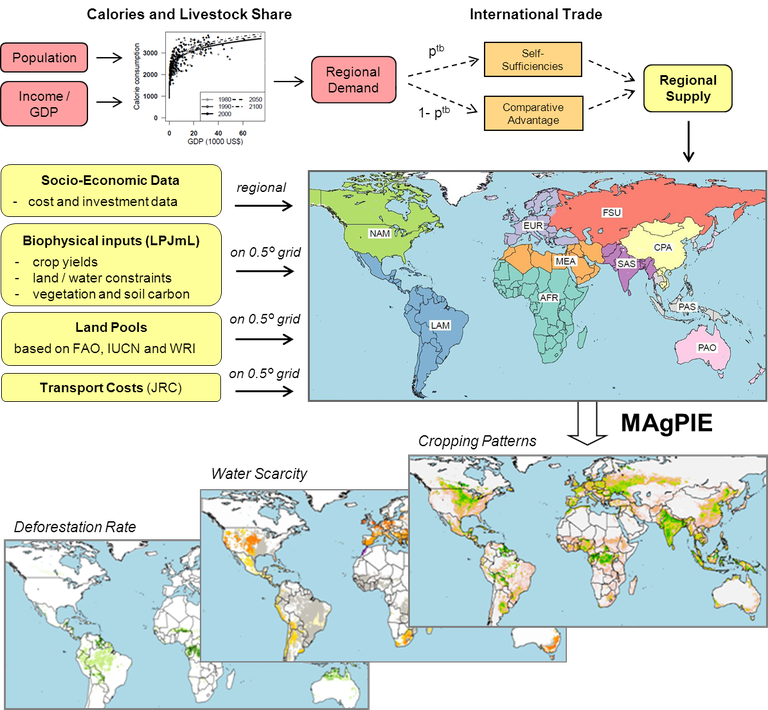Description of the global land use allocation model MAgPIE
The Model of Agricultural Production and its Impact on the Environment (MAgPIE) is a global land use allocation model, which is connected to the grid-based dynamic vegetation model LPJmL, with a spatial resolution of 0.5°x0.5°. It takes regional economic conditions such as demand for agricultural commodities, technological development and production costs as well as spatially explicit data on potential crop yields, land and water constraints (from LPJmL) into account. Based on these, the model derives specific land use patterns, yields and total costs of agricultural production for each grid cell. The objective function of the land use model is to minimize total cost of production for a given amount of regional food and bioenergy demand. Regional food energy demand is defined for an exogenously given population in 10 food energy categories, based on regional diets. Future trends in food demand are derived from a cross-country regression analysis, based on future scenarios on GDP and population growth.

Food and feed energy for the demand categories can be produced by 20 cropping activities and 3 livestock activities. Feed for livestock is produced as a mixture of crops, crop residuals, processing byproducts, green fodder produced on crop land, and pasture. Variable inputs of production are labour, chemicals, and other capital (all measured in US$). Costs of production are derived from the Global Trade Analysis Project (GTAP) Database. The model can endogenously decide to acquire yield-increasing technological change at additional costs. The costs for technological change for each economic region are based on its level of agricultural development, measured as agricultural land-use intensity. These costs grow with further investment in technological change. The use of technological change is either triggered by a better cost-effectiveness compared to other investments or as a response to resource constraints, such as land scarcity.
For future projections the model works on a time step of 10 years in a recursive dynamic mode. The link between two consecutive periods is established through the land-use pattern. The optimized land-use pattern from one period is taken as the initial land constraint in the next. If necessary, additional land from non-agricultural areas can be converted into cropland at additional costs. Potential crop yields for MAgPIE are originally computed with LPJmL at a 0.5° resolution, as weighted average of irrigated and non-irrigated production, if part of the grid cell is equipped for irrigation according to the global map of irrigated areas. In case of purely rain-fed production, no additional water is required, but yields are generally lower than under irrigation. If a certain area share is irrigated, additional water for agriculture is taken from available water discharge in the grid cell. Each cell of the geographic grid is assigned to 1 of 10 economic world regions: Sub-Saharan Africa (AFR), Centrally Planned Asia including China (CPA), Europe including Turkey (EUR), the Newly Independent States of the Former Soviet Union (FSU), Latin America (LAM), Middle East/North Africa (MEA), North America (NAM), Pacific OECD including Japan, Australia, New Zealand (PAO), Pacific (or Southeast) Asia (PAS), and South Asia including India (SAS). The regions are initially characterized by data for the year 1995 on population, gross domestic product (GDP), food energy demand, average production costs for different production activities, and current self-sufficiency ratios for food. Land-conversion activities provide for potential expansion and shifts of agricultural land in specific locations. For the base year 1995, total agricultural land is constrained to the area currently used within each grid cell, according to the dataset of as extended by. Cropland can be converted into rangeland, and vice versa. If additional land is required for fulfilling demand, this can be taken from the pool of non-agricultural land at additional costs. These land-conversion costs force the model to utilize available cropland and rangeland first, and land conversion will become relevant only if land becomes scarce in a certain location or if the marginal cost reductions by producing crops on converted land outweigh the costs of conversion.
Further reading
MAgPIE code on GitHub
MAgPIE documentation (Version 4.6.0)





